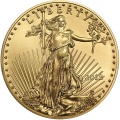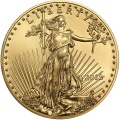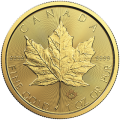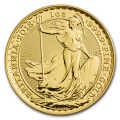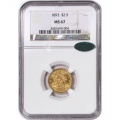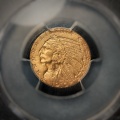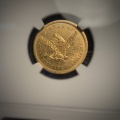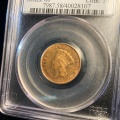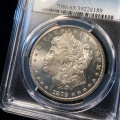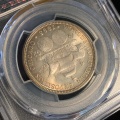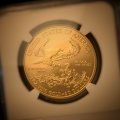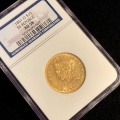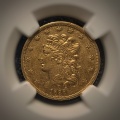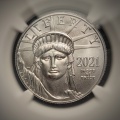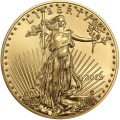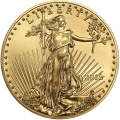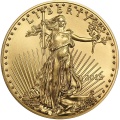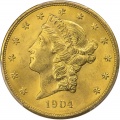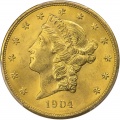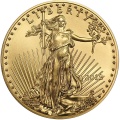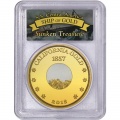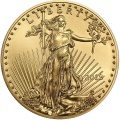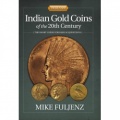May 2022 - Week 4 Edition
Gold and Rare Coins Should Soar During Times of “Stagflation” – Like Now!
The OPEC Oil Embargo in 1973 kicked off nearly a decade of “stagflation,” lasting until 1982. This added a new term to the economics vocabulary, a combination of stagnation (recession) and inflation, which was a condition not thought possible, according to the economics textbooks that said we either had deflation in a recession or inflation in a boom. Then, we had the worst of both worlds – high inflation in a recession.
The 1970s also marked gold’s finest decade, with two major bull markets for both bullion and rare coins. It was also a time when no other investment worked. Stocks and bonds declined in real terms and bank passbook savings accounts were capped at 5.25% by law. Americans could not legally own gold until 1975 or easily buy Swiss francs or other currencies until the 1980s, so rare coins profited above all other investments in the 1970s, growing over 40-fold, according to the PCGS-3000 rare coin index. They rose from a starting value of 1,000 on January 1, 1970, to 41,000 in 1980, increasing over 4,000% as gold rose 2,300%.
The catalyst that pushed gold from $400 to $850 in the first month of 1980 was Russia’s post-Christmas 1979 invasion of Afghanistan. Something like that happened this year, with Russia’s invasion of Ukraine – two nations where 30% of the world’s wheat and corn exports and over 50% of Europe’s energy originate. This has led to massive price increases and shortages in Europe, similar to our gas lines in the 1970s. We’ve since seen a shortage in fertilizer production, leading to a rise in global hunger and food shortages. Also, a new outbreak of COVID-19 in China’s major cities has caused brutal lockdowns in provinces from Shanghai to Beijing.
Last week, former Federal Reserve Board Chairman Ben Bernanke published a new book, written during the COVID-19 lockdown, entitled “21st Century Monetary Policy: The Federal Reserve from the Great Inflation to COVID-19.” In it, he shows how the stagflation of the 1970s is the “closest analogue to what’s happening in today’s economy.” He hopes the current Fed Chair, Jerome Powell, can curb inflation without the extreme measures (20% interest rates, 11% unemployment and two deep recessions) that Fed Chair Paul Volcker engineered from 1979-82, but he also suggested that the country may be heading into stagflation again:
“Even with a favorable scenario, we should have a slowdown in the economy,” he said. “… Inflation's still too high but coming down. So, there should be a period in the next year or two where growth is low, unemployment is at least up a little bit and inflation is still high. So, you could call that stagflation.”
With shortages of food and fuel as far as the eye can see, Russia continuing its brutal war and China leading the world into a trade recession, we are bound for years of inflation and recessions. This economic nightmare is along the lines of the 1970s “stagflation” decade, when gold rose from $35 to $200 from 1971 to 1974, then paused before rising from $103 to $850 between 1976 to 1980 and the rare coin market did even better.
Guide to Buying Gold and Silver Cheaper
A continuing shortage of silver and silver blanks available to the U.S. Mint makes the American Silver Eagle a poor selection for larger purchases in this year’s silver market. However, American Silver Eagles are still great for collectors and for gift giving in small quantities.
There are delays in production and delivery and huge price markups on the order of $13 or more above spot silver prices, which is not practical for larger orders of bullion coins. Imagine paying more than 50% over spot when you can buy the same amount of silver in the same condition for just 10% or 20% over spot prices. With silver recently around $22 per ounce, imagine paying $35 for a silver bullion coin!
Also, current year silver and gold bullion coins are very popular when they are first released but if you want to save on your bullion purchases, you can sometimes buy prior year bullion coins for less than the current year coin. Remember, current year coins become prior year coins in less than 12 months, anyway. We highly recommend, that if you are making large bullion purchases, to always ask if a prior year’s product would save you money on your bullion purchases.
Democrats Will Probably Lose Their Congressional Majority – and That’s Good for Gold
President Biden’s job approval ratings are currently the lowest-ever for a President at this point in the four-year cycle. All four of his predecessors have lost Congressional control in the mid-term elections, three of them in their first term, so it’s fairly certain the Democrats will lose one or both houses of Congress in November. The current betting odds at FTX (where people bet real money) show a 76.4% chance the Republicans will take over the Senate and an 84.7% chance the Republicans will take back the House.
This kind of reversal has happened to each of the last four Presidents, who had higher approval numbers, and it was usually very good for gold:
- On November 8, 1994, Republicans gained eight seats in the Senate and 54 seats in the House to take control of the House for the first time in 40 years as a part of the “Republican Revolution” against President Clinton’s more extreme measure, including his wife’s nationalized healthcare plan. Clinton blamed Fed Chair Alan Greenspan, who raised rates five times in 1994. Gold didn’t react much to the news, since it was flat for most of the 1990s, trading at around $385 in 1995, but gold soared on the huge changes in Congress after each of the next three political reversals:
- On November 7, 2006, Democrats took back a net six seats in the Senate and 31 seats in the House to take back control of both Houses of Congress from the Republicans under George W. Bush. Voters were seemingly tired of the endless wars and deficit spending under the once-cost-conscious (now spendthrift) Republicans. Gold was $625 an ounce on election day 2006 and it rose steadily to $834 a year later, up 33%, despite higher interest rates, courtesy of the Fed.
- On November 2, 2010, there was the most overwhelming reversal of power in any U.S. mid-term election – what Charles Krauthammer called a “restraining order on President Obama” – with Republicans gaining 64 seats in the House, largely as a result of the new “Tea Party” movement. Gold was $1,351 per ounce on election day 2010 and then it rose to $1,743 a year later, up 29%.
- On November 6, 2018, the Democrats gained a net 41 seats in the House to take back control of that chamber, although Republicans remained in control of the Senate. Gold was $1,231 per ounce on election day 2018 but it then rose to $1,509 a year later, up 23% in 12 months.
With all four of the last Presidents seeing their party’s control of Congress reversed in mid-term elections (three in their first term), it is likely Biden and the Democrats will face the same fate this November. That will likely be good for gold, as its price soared an average 21% the last four times such reversals occurred.

Important Disclosure Notification: All statements, opinions, pricing, and ideas herein are believed to be reliable, truthful and accurate to the best of the Publisher's knowledge at this time. They are not guaranteed in any way by anybody and are subject to change over time. The Publisher disclaims and is not liable for any claims or losses which may be incurred by third parties while relying on information published herein. Individuals should not look at this publication as giving finance or investment advice or information for their individual suitability. All readers are advised to independently verify all representations made herein or by its representatives for your individual suitability before making your investment or collecting decisions. Arbitration: This company strives to handle customer complaint issues directly with customer in an expeditious manner. In the event an amicable resolution cannot be reached, you agree to accept binding arbitration. Any dispute, controversy, claim or disagreement arising out of or relating to transactions between you and this company shall be resolved by binding arbitration pursuant to the Federal Arbitration Act and conducted in Beaumont, Jefferson County, Texas. It is understood that the parties waive any right to a jury trial. Judgment upon the award rendered by the Arbitrator may be entered in any court having jurisdiction thereof. Reproduction or quotation of this newsletter is prohibited without written permission of the Publisher.


